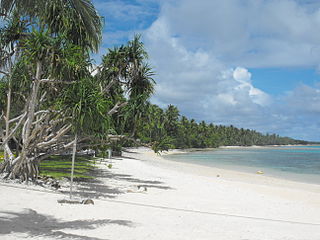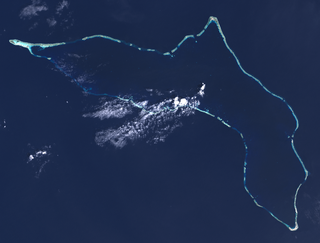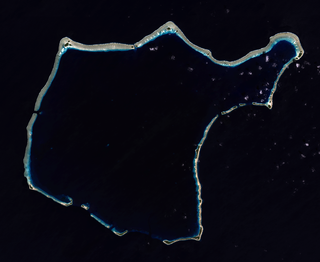
The Marshall Islands, officially the Republic of the Marshall Islands, is an island country west of the International Date Line and north of the equator in the Micronesia region in the Northwestern Pacific Ocean.
The demographics of the Marshall Islands include data such as population density, ethnicity, health of the populace, economic status, religious affiliations and other aspects of the population.
Austronesian settlers arrived in the Marshall Islands in the 2nd millennium BC, but there are no historical or oral records of that period. Over time, the Marshallese people learned to navigate over long ocean distances by walap canoe using traditional stick charts.

Majuro is the capital and largest city of the Marshall Islands. It is also a large coral atoll of 64 islands in the Pacific Ocean. It forms a legislative district of the Ratak (Sunrise) Chain of the Marshall Islands. The atoll has a land area of 9.7 square kilometers (3.7 sq mi) and encloses a lagoon of 295 square kilometers (114 sq mi). As with other atolls in the Marshall Islands, Majuro consists of narrow land masses. It has a tropical trade wind climate, with an average temperature of 27 °C (81 °F).

Kwajalein Atoll is part of the Republic of the Marshall Islands (RMI). The southernmost and largest island in the atoll is named Kwajalein Island, which its majority English-speaking residents often use the shortened name, Kwaj. The total land area of the atoll amounts to just over 6 square miles (16 km2). It lies in the Ralik Chain, 2,100 nautical miles southwest of Honolulu, Hawaii.

Bikini Atoll, known as Eschscholtz Atoll between the 19th century and 1946, is a coral reef in the Marshall Islands consisting of 23 islands surrounding a 229.4-square-mile (594.1 km2) central lagoon. The atoll is at the northern end of the Ralik Chain, approximately 530 miles (850 km) northwest of the capital Majuro.

Jaluit Atoll is a large coral atoll of 91 islands in the Pacific Ocean and forms a legislative district of the Ralik Chain of the Republic of the Marshall Islands. Its total land area is 11.34 square kilometers (4.38 sq mi), and it encloses a lagoon with an area of 690 square kilometers (270 sq mi). Most of the land area is on the largest islet (motu) of Jaluit (10.4 km2). Jaluit is approximately 220 kilometers (140 mi) southwest of Majuro. Jaluit Atoll is a designated conservation area and Ramsar Wetland.

Rongelap AtollRONG-gə-lap is an uninhabited coral atoll of 61 islands in the Pacific Ocean, and forms a legislative district of the Ralik Chain of the Marshall Islands. Its total land area is 8 square miles (21 km2). It encloses a lagoon with an area of 1,000 square miles (2,600 km2). It is historically notable for its close proximity to US hydrogen bomb tests in 1954, and was particularly devastated by fallout from the Castle Bravo test. The population asked the US to move them from Rongelap following the test due to high radiation levels, but with no success; so they asked global environmental group Greenpeace to help. The Rainbow Warrior made three trips moving the islanders, their possessions and over 100 tons of building materials to the island of Mejato in the Kwajalein Atoll, 180 kilometers away.

Rongerik Atoll or Rongdrik Atoll is an unpopulated coral atoll of 17 islands in the Pacific Ocean, and is located in the Ralik Chain of the Marshall Islands, approximately 200 kilometers (120 mi) east of Bikini Atoll. Its total land area is only 1.68 square kilometers (0.65 sq mi), but it encloses a lagoon of 144 square kilometers (56 sq mi).

Kili Island or Kili Atoll is a small, 81 hectares island located in the Marshall Islands in the Pacific Ocean. As of 2021, 415 people lived on the island, many of whom were descended from islanders who originally lived on Bikini Atoll. They were relocated when they agreed to let the U.S. government temporarily use Bikini for nuclear testing in 1945, which they were told was of great importance to humankind, though it is sometimes considered a forced relocation. Kili Island became their home after two prior relocations failed. The island does not have a natural lagoon and cannot produce enough food to enable the islanders to be self-sufficient. It is part of the legislative district of the Ralik Chain of the Marshall Islands. The island is approximately 48 kilometers (30 mi) southwest of Jaluit. It is a good sized island for the Marshall Islands, but it is not an atoll with a lagoon.

Namdrik Atoll or Namorik Atoll is a coral atoll of two islands in the Pacific Ocean, and forms a legislative district of the Ralik Chain of the Marshall Islands. Its total land area is only 2.8 square kilometers (1.1 sq mi), but it encloses a lagoon with an area of 8.4 square kilometers (3.2 sq mi). The atoll had a population of 299 at the 2021 census.

The culture of the Marshall Islands forms part of the wider culture of Micronesia. It is marked by pre-Western contact and the impact of that contact on its people afterward. The Marshall Islands were relatively isolated. Inhabitants developed skilled navigators, able to navigate by the currents to other atolls. Prior to close contact with Westerners, children went naked and men and women were topless, wearing only skirts made of mats of native materials.
Japanese settlement in the Marshall Islands was spurred on by Japanese trade in the Pacific region. The first Japanese explorers arrived in the Marshall Islands in the late 19th century, although permanent settlements were not established until the 1920s. As compared to other Micronesian islands in the South Seas Mandate, there were fewer Japanese who settled in the islands. After the Japanese surrender in 1945, the Japanese populace were repatriated to Japan, although people of mixed Japanese–Marshallese heritage remained behind. They form a sizeable minority in the Marshall Islands' populace, and are well represented in the corporate, public and political sectors in the country.

Lesbian, gay, bisexual, and transgender (LGBT) people in the Marshall Islands may face legal challenges not experienced by non-LGBTQ residents. Same-sex sexual activity has been legal in the Marshall Islands since 2005, and discrimination on the basis of sexual orientation and gender identity has been outlawed in all areas since 2019. Despite this, households headed by same-sex couples are not eligible for the same legal protections available to opposite-sex married couples, as same-sex marriage and civil unions are not recognized.
Darlene Keju, also known as Darlene Keju-Johnson, was a Marshallese activist. She was born on Ebeye Island in the Marshall Islands group in 1951. The Northern Islands where she grew up were downwind from Bikini and Enewetak atolls where the United States tested 67 nuclear weapons. She witnessed the evacuation of Regelap and Utirik Atolls after they were contaminated by radioactive fallout. Keju is credited for bringing to the attention of the world the suffering of the Marshall Islanders as a result of the nuclear testing and that many more people were affected than acknowledged by the U.S. government.

Hilda Cathy Heine is a Marshallese educator and politician. She has been serving as the president of the Marshall Islands since 2024, having previously served from 2016 to 2020. Heine was the first woman to lead any sovereign country in Micronesia and the first person from the Marshall Islands to earn a doctorate. Prior to entering politics, she worked as a teacher and counselor at Marshall Islands High School and then as a women's rights activist with her organization Women United Together Marshall Islands.

Kathy Jetn̄il-Kijiner is a poet and climate change activist from the Marshall Islands.
Marshallese nationality law is regulated by the Marshallese Constitution of 1979, as amended; the 1984 Citizenship Act of the Marshall Islands, and its revisions; and international agreements entered into by the Marshallese government. These laws determine who is, or is eligible to be, a national of the Marshall Islands. The legal means to acquire nationality, formal membership in a nation, differ from the domestic relationship of rights and obligations between a national and the nation, known as citizenship. Marshallese nationality is typically obtained either on the principle of jus soli, i.e. by birth in the Marshall Islands or under the rules of jus sanguinis, i.e. by birth abroad to parents with Marshallese nationality. It can be granted to persons with an affiliation to the country, or to a permanent resident who has lived in the country for a given period of time through naturalization.
Kathryn Relang is a Marshallese women's rights activist, who is a former Executive Director of Women United Together Marshall Islands (WUTMI).
There is a population of Marshallese people in Northwest Arkansas, concentrated in Springdale.













